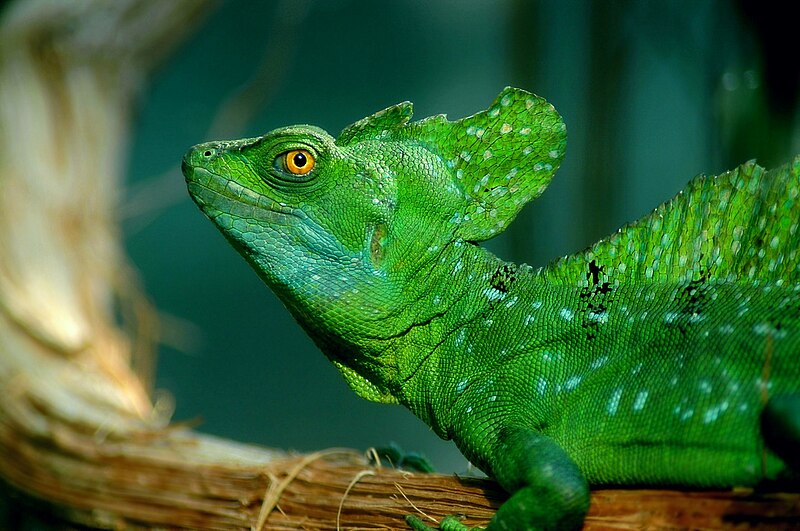We are quite fortunate that so attractive and interesting a lizard as the Green Basilisk (Basiliscus plumifrons) also breeds well in captivity. Two related species, the American or Brown Basilisk (B. basiliscus) and the Banded Basilisk (B. vittatus) may also be bred as described below. The fourth species in the genus, the Western Basilisk (B. galeritus) is not often kept or bred.
Enthusiastic Breeders
 Green Basilisks make things easy for their owners – unlike many reptiles, they seem not to need changing temperatures, rain or other environmental stimulation in order to come into breeding condition. Although reproduction is influenced by seasonal changes in the wild, well-nourished captives may breed year-round. In fact, it is important to monitor females carefully, as they may become egg-bound if unable to find a proper nesting site.
Green Basilisks make things easy for their owners – unlike many reptiles, they seem not to need changing temperatures, rain or other environmental stimulation in order to come into breeding condition. Although reproduction is influenced by seasonal changes in the wild, well-nourished captives may breed year-round. In fact, it is important to monitor females carefully, as they may become egg-bound if unable to find a proper nesting site.
Nutritional Considerations
Nutrition is critical – reproductively-active females should be fed minnows on a regular basis (I provide minnows 1x weekly) and most meals should be dusted with vitamin/mineral supplements; alternating among Reptivite with D3, ReptiCalcium and ReptoCal works well. Pink mice can be offered once monthly…over-use, however, may result in corneal lipid deposits and other nutritional problems.
A powerful UVB-emitting bulb is essential. If possible, arrange the basking site to be within 6-12 inches of the bulb.
Males are intensely territorial…even in huge terrariums, it is usually impossible to keep 2 males together. One male may be housed with 2-3 females.
The Nest Site
 Provide your female Green Basilisk with moist soil of at least 12 inches in depth in which to construct a nest. A small bulb suspended over this site, raising the soil temperature to 85F, will increase it’s attractiveness to her. The actual nest averages 6-10 inches in depth, although 2 females I’ve cared for only dug down 2 inches or so (but both produced quite large clutches, as I remeber – perhaps they were in a hurry!).
Provide your female Green Basilisk with moist soil of at least 12 inches in depth in which to construct a nest. A small bulb suspended over this site, raising the soil temperature to 85F, will increase it’s attractiveness to her. The actual nest averages 6-10 inches in depth, although 2 females I’ve cared for only dug down 2 inches or so (but both produced quite large clutches, as I remeber – perhaps they were in a hurry!).
Seven to 15 eggs (average 10), laid at 3-5 minute intervals, will be deposited in the nest hole, which is then carefully re-filled with soil through the use of both front and rear legs.
Further Reading
Range and other information about all 4 Basilisk species is posted here.
Plumed Basilisk image referenced from wikipedia and originally posted by Hans Hilliwaert
Plumed Basilisk close up image referenced from wikipedia and originally posted by Marcel Burkhard
 That Reptile Blog – Reptile, Amphibian and Exotic Pet Care and Information
That Reptile Blog – Reptile, Amphibian and Exotic Pet Care and Information


